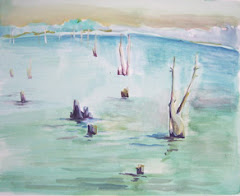
Bayou Bienvenue Cypress Triangle-a completely destroyed wetland.

Lock on the Industrial Canal

Industrial Canal-Lower 9th side.

The Levee at Bayou Bienvenue Cypress Triangle.
So much of what needs to happen here depends on healthy wetlands. Without that foundation none of it will work in the long term. All politics aside, this is probably the most important problem to fix.

Spartina awaiting wetland planting
in the nursery at Common Ground.
Today I visited The Bayou Bienvenue Cypress Triangle. This is located on the line between Orleans and St. Bernard parish -north of L9. This was a thriving Cypress forest less than 20 years ago.
See video
The situation is this. in the late 60’s a canal called The Mississippi River-Gulf Outlet Canal (also known as MRGO, MR-GO or “Mr. Go”) was built for a shorter shipping route into New Orleans rather than take the Mississippi River which twists and turns. The problem is that the Gulf flows into it and brings salt water into inland fresh water. The wetlands make the transition between salt and non salt water. Inland plants don’t tolerate salt. Cypress trees are salt tolerant but not enough to withstand the salt that is coming in now. The lower 9th was once a cypress swamp.
Long-time Lower Nine residents remember a time before the Mississippi River-Gulf Outlet flooded the bayou with saltwater and killed the native cypress trees and swamp just north of the Lower Nine. They remember when there was more dry land than wet.
There was a lot of fishing and social activity on the bayou. When the steel levee went up around the bayou after Hurricane Betsy it separated the bayou from the community.
Work done by Hassam Mahriqui in a computer simulation at Louisiana State University’s Hurricane Center of MR-GO during Katrina found that it had raised the storm surge. Three months before Katrina, Mashriqui, a storm surge expert, called MR-GO a “critical and fundamental flaw” in the Corps’ hurricane defenses, a “Trojan Horse” that could amplify storm surges 20 to 40 percent. Following the storm, an engineering investigation and computer modelling showed that the outlet intensified the initial surge by 20 percent, raised the height of the wall of water about three feet, and increased the velocity of the surge from 3 feet per second (0.9 m/s) to 8 feet per second (2.4 m/s) in the funnel. Mashriqui believes this contributed to the scouring that undermined the levees and flood walls along the outlet and Industrial Canal. “Without MRGO, the flooding would have been much less,” he said. “The levees might have overtopped, but they wouldn’t have been washed away.”
St. Bernard Parish insists that only total closure can restore the wetlands destroyed by the MRGO. The plan proposed by the State of Louisiana also calls for the complete closure of the MRGO.

Barges in the Industrial Canal

Alligator in some really dirty garbage filled water in
some sort of catchment system from the Industrial Canal.
MISCELLANEOUS NEW ORLEANS SCENES

New modular shotgun for sale in L9


There is so so so much of this...and worse

Something was on fire here. It is not unusual to see a lot of burnt out buildings.

Here is a shot of the memorial built on the meridian of Claiborne which is the main road through the Lower 9th. It was built hastily before a Bush visit. Who would ever go here? Its really awful and it is the only place the city mows in L9-everything else is mowed by volunteers or residents.

yep
See ya tomorrow...S





































